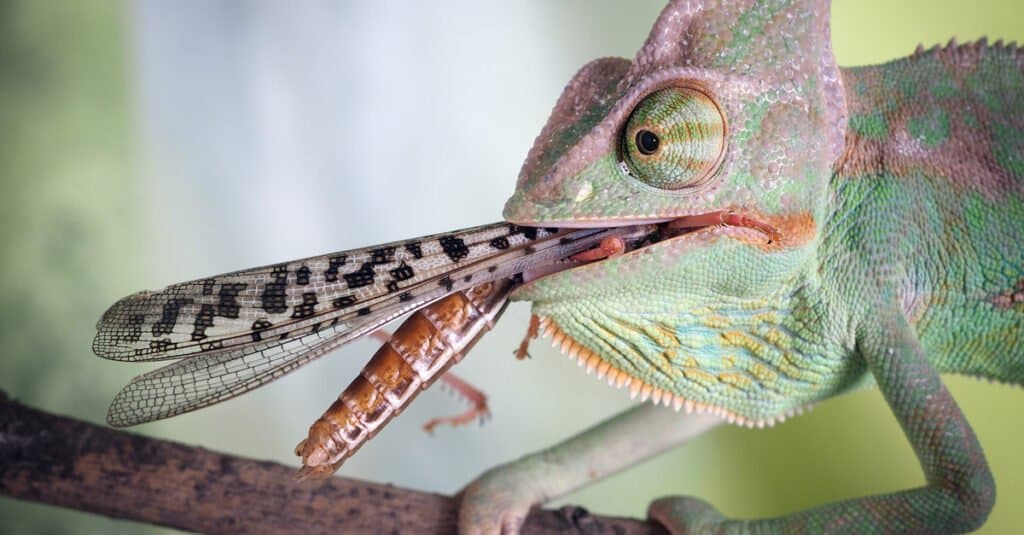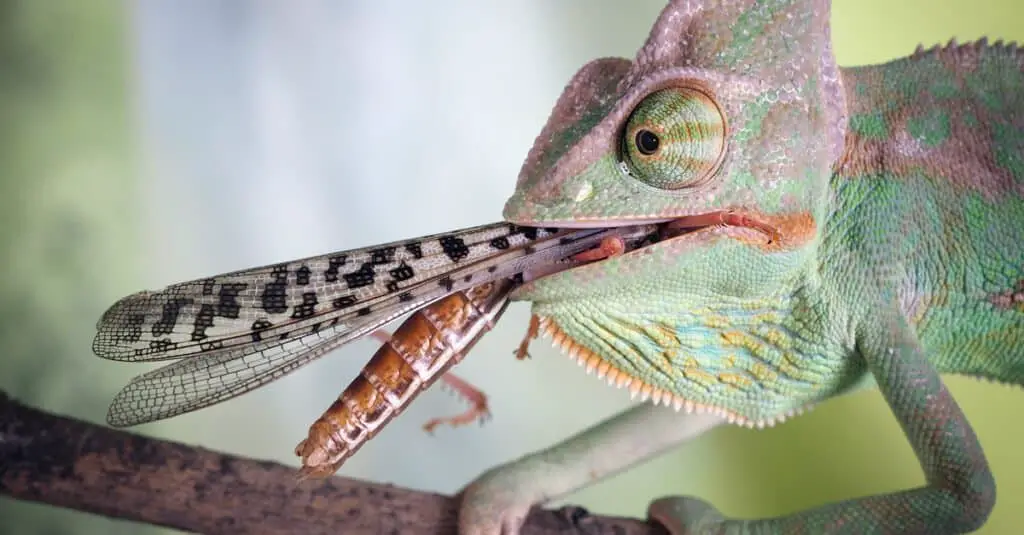Chameleons are fascinating creatures that are known for their ability to change colors to blend in with their surroundings. However, their unique feeding habits are just as intriguing. Have you ever wondered how chameleons eat and what makes their approach to feeding so different from other animals? In this article, we’ll explore the fascinating world of chameleon feeding and uncover the secrets behind their remarkable feeding strategy.
From their long, sticky tongues to their independently moving eyes, chameleons have evolved a set of specialized adaptations to help them catch prey in their natural habitats. Whether they are hunting insects or munching on leaves, chameleons employ a unique combination of stealth, patience, and lightning-fast reflexes to get the job done. Join us as we take a closer look at these fascinating creatures and discover the secrets of their impressive feeding habits.

How Do Chameleons Eat?
Chameleons are fascinating creatures that are known for their ability to change color and blend into their surroundings. However, they are also unique in the way that they eat. Unlike most animals, chameleons have a long, sticky tongue that they use to catch their prey. But how does this process work? In this article, we’ll take a closer look at how chameleons eat.
1. Anatomy of the Chameleon’s Tongue
The chameleon’s tongue is one of its most distinctive features. It is long, muscular, and covered in mucus and sticky saliva. When the chameleon spots its prey, it rapidly extends its tongue, which can be up to twice the length of its body. The sticky saliva on the tongue adheres to the prey, and the chameleon quickly retracts its tongue, bringing the prey back into its mouth.
The tongue is not the only unique part of the chameleon’s anatomy. Chameleons also have independently moving eyes, which allow them to scan their surroundings for prey without moving their head. They also have long, slender fingers and toes that are adapted for gripping branches and climbing.
2. What Do Chameleons Eat?
Chameleons are primarily insectivores, which means they eat insects. Some of the most common prey items for chameleons include crickets, grasshoppers, and flies. However, chameleons have also been known to eat small birds and lizards.
One of the reasons that chameleons are such effective hunters is their ability to remain motionless for long periods of time. They can sit and wait for prey to come within range of their long tongue, and then strike quickly and accurately.
3. The Mechanics of Chameleon Feeding
When a chameleon sees a potential prey item, it will focus its eyes on the target and calculate the distance. Then it will slowly move its head closer to the prey, until it is within range of its tongue. The chameleon will then rapidly extend its tongue, which can reach speeds of up to 60 miles per hour.
When the tongue makes contact with the prey, the sticky saliva on the tongue adheres to the prey’s body. The chameleon then retracts its tongue, bringing the prey back into its mouth. The chameleon’s teeth are adapted for crushing and grinding the hard exoskeletons of insects.
4. The Benefits of Chameleon Feeding
Chameleons have a unique feeding strategy that allows them to catch prey with incredible speed and accuracy. This makes them highly effective hunters, and allows them to survive in environments where other animals might struggle to find food.
In addition, chameleons are able to eat a wide variety of prey items, which gives them a greater chance of finding food in their environment. This adaptability is a key factor in the chameleon’s success as a species.
5. The Versatility of the Chameleon’s Tongue
The chameleon’s tongue is not just long and sticky, it is also incredibly versatile. Chameleons can use their tongue to catch prey in a variety of different positions, including upside down and even backwards.
This versatility is due to the unique structure of the chameleon’s tongue. It is made up of a series of interconnected muscles and bones, which allow it to move in a wide range of directions. This gives the chameleon a significant advantage when it comes to catching prey.
6. Chameleon Feeding and Social Behavior
Chameleons are primarily solitary animals, and they do not interact with other chameleons except during mating season. However, feeding behavior can sometimes lead to interactions between chameleons.
For example, if two chameleons spot the same prey item, they may both try to catch it. This can lead to competition between the two animals, and sometimes even fights. However, these interactions are relatively rare, as chameleons are usually able to find enough food in their environment without competing with other animals.
7. The Role of Color Change in Chameleon Feeding
Chameleons are known for their ability to change color, and this ability is often thought to be linked to their feeding behavior. However, the role of color change in chameleon feeding is not well understood.
Some researchers believe that chameleons use color change to blend in with their surroundings, making it easier to catch prey. Others think that chameleons change color to communicate with other chameleons, or to regulate their body temperature.
8. Feeding and Digestion in Chameleons
Once the chameleon has caught its prey, it must be digested. Chameleons have a relatively slow metabolism, which means that they can go for long periods of time without eating. However, when they do eat, they need to digest their food quickly in order to avoid predation.
Chameleons have a two-chambered stomach, which is adapted for the digestion of insects. The first chamber contains digestive enzymes, while the second chamber is where the actual digestion takes place. The chameleon’s liver also plays a key role in digestion, as it produces bile that helps to break down fats.
9. Chameleon Feeding in Captivity
Chameleons are popular pets, and many people keep them in captivity. However, feeding chameleons in captivity can be challenging, as they require a diet that is rich in nutrients and vitamins.
In order to ensure that captive chameleons receive a balanced diet, it is important to feed them a variety of different insects, such as crickets, mealworms, and waxworms. It is also important to provide them with access to fresh water and a source of calcium, which is essential for their bone health.
10. Conclusion
In conclusion, chameleons are fascinating creatures with a unique feeding strategy. Their long, sticky tongue and independently moving eyes make them highly effective hunters, and their adaptability allows them to survive in a variety of different environments.
If you are considering keeping a chameleon as a pet, it is important to understand their feeding requirements and to provide them with a balanced diet. With the right care and attention, chameleons can make wonderful and fascinating pets.
Frequently Asked Questions
Are you curious about chameleons and how they eat? Here are some frequently asked questions and answers to help you understand their unique feeding habits.
How do chameleons catch their prey?
Chameleons are carnivorous and mainly eat insects. They have a long and sticky tongue that can extend up to twice their body length. When they spot their prey, they shoot out their tongue at lightning speed to catch it. The tongue is covered in mucus, which helps to stick the prey to it. Once the prey is caught, the chameleon retracts its tongue back into its mouth and chews the food with its small and sharp teeth.
Chameleons are also known for their incredible eyesight and can spot their prey from a distance. They can move their eyes independently, which allows them to have a 360-degree view of their surroundings. This helps them to detect any movement and find their next meal.
What do chameleons eat?
Chameleons eat a variety of insects, including crickets, grasshoppers, and flies. They are also known to eat spiders and other small animals. Some species of chameleons, such as the Veiled Chameleon, may also eat plant matter, such as leaves and flowers.
It is important to ensure that the insects fed to chameleons are gut-loaded, which means that they have been fed a nutritious diet before being fed to the chameleon. This helps to provide the chameleon with the necessary nutrients for its growth and development.
How often do chameleons eat?
Chameleons do not have a set feeding schedule and may go for days without eating. This is because they are able to store fat reserves in their bodies, which they can use as energy when food is scarce. However, it is recommended to feed adult chameleons every other day and juvenile chameleons daily.
It is important to monitor their weight and adjust their feeding schedule accordingly. Overfeeding can lead to obesity and health problems, while underfeeding can lead to malnutrition and stunted growth.
Can chameleons drink water?
Chameleons do not drink water in the traditional sense. Instead, they absorb water through their skin and the moisture on the leaves of the plants they live on. It is important to mist their enclosure daily to provide them with the necessary humidity and moisture.
Some species of chameleons, such as the Panther Chameleon, may also drink water droplets that form on the leaves after it rains. This is why it is important to provide them with live plants in their enclosure, as they help to maintain the necessary humidity levels.
Can chameleons eat fruits and vegetables?
Chameleons are primarily carnivorous and do not require fruits and vegetables in their diet. However, some species of chameleons, such as the Veiled Chameleon, may eat plant matter in the wild. It is important to provide them with a balanced diet that includes live insects and gut-loaded plant matter, such as leaves and flowers.
It is also important to note that some fruits and vegetables can be harmful to chameleons, so it is best to stick to their natural diet of insects and plant matter.
What fruits and vegetables to feed to a chameleon
In conclusion, chameleons have a unique way of eating that sets them apart from other animals. Their long, sticky tongue and independently moving eyes allow them to catch and track prey with impressive accuracy. Their slow and deliberate movements also help them to avoid detection by potential predators.
Despite their specialized feeding habits, chameleons still face challenges in their natural habitats. Habitat destruction, climate change, and the illegal pet trade all pose threats to their survival. It’s important that we work to protect these fascinating creatures and their ecosystems.
Overall, learning about chameleons and their eating habits can give us a greater appreciation for the diversity of life on our planet. By taking steps to protect their habitats and reduce our impact on the environment, we can help ensure that these incredible animals continue to thrive for generations to come.


